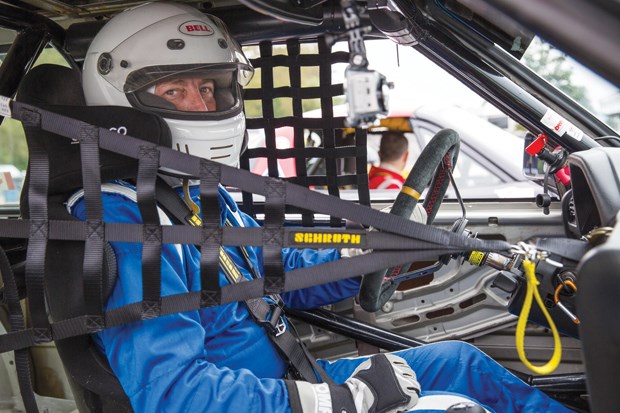Malcolm Curtis admits he has been off the track a few times.
He has also had a few accidents, but they weren’t his fault. He was hit by other drivers.
“My car got beaten up last year a little bit,” he notes, saying of the other drivers: “They were having their own race and they weren’t paying attention and didn’t break properly.”
It’s all par for the course, though.
Curtis, a North Vancouver resident and millwright by trade, is a regular participant in the Pro 3 series, a spec series run by Sports Car Club of B.C. Racers in this series navigate a 1.2-mile, nine-turn road course at Mission Raceway Park during a season that runs from May to October with eight weekend events featuring three races at each event.
“On ovals they only turn left. We turn left and right,” explains Curtis of the road course.
A spec series is a series that features cars with similar specifications, and drivers are only allowed to modify the same certain elements of their cars. For this series, drivers can do modifications to the suspension, brakes, tires, and a few other things. For example, they fix the suspension so they can lower the ride height of the car to get better control around corners since lowering the car lowers the centre of gravity.
Curtis drives a modified 1987 BMW 325i.
“My car being a sedan they call us the tin tops,” he says.
The Beemer is fitted with plenty of safety gear, including a full roll cage, an FIA-certified race bucket seat, a five-point harness, and fire extinguisher. Drivers wear crash helmets with a head-and-neck restraint device.
“The cars are very safe,” says Curtis, who is a member of a four-person group called Red Zone Racing. Drivers try to avoid contact on the track, but it’s inevitable, he adds.
This is club-level racing, so there are no sponsors and no prize money. All investment in the sport falls on the drivers, and Curtis admits: “It’s just a big money pit.”
But he loves it.
“I call it my addiction,” he notes.
Curtis spent much of this season in the middle of the pack and, with one race weekend left in October, expects to finish third overall.
“To get into second or first place I think I’d have to cheat a little bit with my car and I’m not allowed to so I won’t,” he says, laughing.
Originally from South Africa, Curtis spent some time with rally racing in his younger days, and considered revisiting it here in B.C., but couldn’t afford to do both rally and road racing, so chose the latter.
The main difference between the two types of driving is car control.
In rallying the car is for most of the time out of control because the driver wants to be able to switch it to go in whichever direction he or she needs it to go, explains Curtis.
“In my day it was a road you’d never seen in your life before,” he adds. Drivers were given a drawing from race organizers and a navigator read out to the driver where they were going. “So you kept the car very much unbalanced the whole time.”
In road racing the car is very balanced. All the braking is done in a straight line.
“You’re keeping your car as controlled as possible,” he notes.
The more controlled and adept a driver can be in keeping turns neat, the faster the car can go on a road course. When practising for a race, Curtis says he mainly focuses on running the lines.
“The ‘lines’ are the entrance, the apex, and the exit of the corner. And if you get those really down pat you can gain a lot on somebody else who is all over the place.”
During the off-season, Curtis and his fellow Red Zone Racing drivers examine footage of their races and tinker with their cars.
“The main thing we do during the off-season is tear our cars apart and rebuild them and fix them up,” says Curtis.
Basic maintenance is ongoing, and Curtis says he goes through about a set and a half of tires each season. Brake pads are changed regularly, rotors too, and Curtis does an oil change after each race weekend because the engine is running at super high rpm for six 20-minute sessions per weekend.
“That engine is pretty much screaming the whole time,” says Curtis. “I just feel sorry for it,” he adds with a laugh.
At 54, Curtis has no plans to slow down. One of the drivers in the series is 82, so he’s got a while to go yet before he even considers retiring, and he has the full support of his family, which includes his wife and two daughters, all of whom regularly attend his races. His wife helps with his schedule and is a valued member of his team, notes Curtis.
Although both of his kids love motor sports, neither is interested in becoming a driver, says Curtis. But he is currently mentoring his 14-year-old granddaughter, who has plans to race. He looks forward to a day when they might race together.
When asked if he would let her win, he answers quickly: “Sure I would, of course, why not?”
Contact Rosalind Duane at [email protected].



